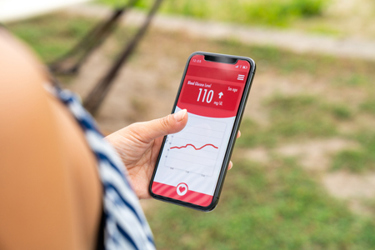Medtech CEO Shares Lessons From FIH Implantable Glucose Monitor Trial
A conversation with Paul Goode, Ph.D., president and CEO, Glucotrack

Roughly 2.4 million people in the U.S. use a continuous glucose monitor (CGM). Sometimes, patients who wear them experience undesired effects, such as painful sensor insertion, ongoing skin irritation, device dependence, and, for some, the inability to afford such sensors. Medically speaking, continuous glucose monitors (CGM) can exhibit variations in sensor accuracy and data efficiency and accuracy, specifically if they measure glucose levels in interstitial fluid, not blood.
Glucotrack has developed and is studying a long-term implantable CBGM. In this Q&A, CEO and President Paul Goode, Ph.D., explores the implantable CBGM’s trial design, as well as the company’s approach to patient input, site selection, and more for its first-in-human trial.
Clinical Leader: Before beginning the FIH trial, how did Glucotrack solicit and use patient feedback to design and develop the device and/or the trial?
Paul Goode, Ph.D.: We set up a robust market research program to gather patient insights and perspectives throughout the development process. Last year, we completed a survey of 757 people living with type 1 and type 2 diabetes.
We found a positive sentiment, with over 50% of people interested in acquiring our CBGM. We also learned that the top three most appealing aspects — long-term sensor lifespan, ability to measure blood glucose directly, and lack of a wearable component — were consistent across all segments surveyed. During that research, we also tested different length, width, and height combinations, and our final design was chosen based on direct patient feedback.
Patient adherence in clinical research can make or break trial data. Because this CBGM device is implanted and requires no calibration by the patient, to what extent was patient adherence a concern for you with this trial and in future trials?
By eliminating the need for a wearable component, our system resolves challenges with continuous glucose monitoring, including adhesive skin irritation, sensor detachment during activities or near the end of the sensor’s life, and the burden of replacing a sensor, either per schedule or prematurely. We believe this will reduce the patient adherence burden to essentially just keeping their smartphone nearby. With CGMs and CBGMs, the smartphone receives the sensor data (via Bluetooth) and displays it for the patient. It also enables the patient to set alert thresholds for high and low glucose and see statistics on their glycemia.
In addition, how do you believe the modality of this device, being implanted, will affect the patient experience?
The CBGM enables a less burdensome approach to glucose monitoring that, we believe, will positively impact the patient experience. We anticipate seeing this not only in patient adherence in clinical research but also once the system is available commercially. Adding to the clinical trial benefits, we will also reduce the patient’s burden of procuring and managing supplies and dealing with regular copayments.
We believe that a long-term system that measures blood glucose in real time without the delays seen with interstitial readings and with no on-body wearable component establishes new standards in accuracy, convenience, and independence.
The current wearable CGM products last 7-15 days before needing replacement. There is one implantable CGM, which also requires a wearable component to power the implant, and it lasts 365 days (one year). There are two other implantable CGMs in development are targeting a 6-month life and a 12-month life, respectively. Our target is a 36-month (3-year) life.
How will it impact data capture and analysis, especially as compared with subcutaneous CBGMs?
Other than ensuring smartphone connectivity, the patient doesn’t need to do anything special to receive glucose readings. Because of this simplicity, we expect very high data capture rates.
Essentially, all commercial CGMs, and those in development, are all measuring interstitial fluid glucose. That lags the blood up to 15 minutes depending on certain activities (e.g., eating, exercising, stress, illness). We are measuring in the blood, so ours would be considered ‘real time’ (no lag). While 15 minutes seems minimal, it is very important for making an intervention for a high glucose (dose with insulin) or low glucose (consume carbohydrates) to prevent a more severe outcome.
Glucotrack identified Dr. Alexander Abizaid at InCor in Brazil to treat the first person enrolled in the trial. What about this principal investigator, the site, and/or the country of Brazil was attractive to Glucotrack for this trial — whether it is expertise, patient population, regulatory support, and/or something else?
Well, to start, you might wonder, “Why is a diabetes study being performed by an interventional cardiologist?” The Glucotrack system is similar in size and form factor to active implantables in the cardiovascular space. So, the placement procedure is recognizable and widely performed by interventional cardiologists who are experienced in cardiac pacemaker procedures. Placement is performed as an outpatient procedure, under local anesthesia in a cardiac cath lab. The procedure takes approximately 20 minutes and only requires a small, half-inch incision.
We chose InCor because it has been repeatedly recognized as the best cardiology and cardiovascular surgery hospital in Latin America. Dr. Alexandre Abizaid, the director of interventional cardiology at InCor, is also a visiting professor of medicine at Columbia University Medical Center and serves on the faculty of the Cardiovascular Research Foundation in New York. He is well-known for performing similar first-in-human trials in the cardiovascular space.
The study involved a four-day hospital stay for implant placement, use, and removal. When developing the protocol, what or who were some of the resources Glucotrack relied upon?
Given the nature of the technology, we have a team of clinical advisors with expertise in both the endocrinology and cardiovascular spaces. We collaborate closely with this group and relied on their expertise for protocol development.
Additionally, we recently announced that Guillermo Umpierrez, MD, CDCES, FACE, MACP, has been named to our medical advisory board. He has extensive experience leading and participating in clinical research, and his work has significantly advanced the understanding and treatment of diabetes. In this role, Dr. Umpierrez will provide clinical and scientific knowledge to support the development of the CBGM.
Since the study met its primary endpoint (safety) and had no procedure- or device-related SAEs, what is the next step in researching the safety and efficacy of the implantable CBGM?
With this initial study, we demonstrated that the insertion, use, and removal of the sensor lead is safe and the prototype electronics performed as expected. The next step for us is the long-term clinical evaluation of the CBGM technology, which we are planning to begin this year in Melbourne, Australia.
Why Australia?
We chose Australia because our newly-hired clinical and regulatory executives had positive experience with an implantable CGM in the clinical center we will work with, the Australian medical practice is similar to the U.S. and EU, and the Australian government offers tax incentives.
Finally, what plans are there for post-marketing surveillance and the collection of real-world data?
Since we are presently a few years away from commercialization, our focus this year is on our long-term OUS clinical trial and then starting the process of FDA regulatory review for our U.S. pilot clinical trial. Once commercial in a few years, we plan to continue collecting data on our U.S. pivotal trial patients to extend the CBGM longevity indication. We also intend to support post-market clinical studies with key investigators in both the U.S. and abroad.
About The Expert:
 Paul is a medical device executive with extensive experience spanning operations and product development, from concept to global commercialization. Prior to becoming president and CEO of Glucotrack, he served on the board of directors at Integrity Applications.
Paul is a medical device executive with extensive experience spanning operations and product development, from concept to global commercialization. Prior to becoming president and CEO of Glucotrack, he served on the board of directors at Integrity Applications.
With over 2 decades in the medical device industry, Paul has specialized in innovative diabetes management technologies. He has held roles as vice president of R&D at MetaCure, director of engineering and algorithm development at DexCom, and senior engineer at MiniMed, Inc., prior to its acquisition by Medtronic.
Paul holds BS, MS, and Ph.D. degrees from North Carolina State University and is credited as an inventor on over 150 issued patents, with over 100 relating to DexCom’s continuous glucose sensing technology.
